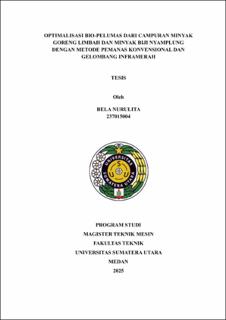| dc.description.abstract | Energy consumption around the world is still very dominated by fossil energy sources, both lubricants and fuels. The source of energy raw materials is not renewable and not environmentally friendly. Therefore, many researchers and industry players have been looking for renewable and environmentally friendly energy sources. This study aims to optimize the production of biolubricants from a mixture of used cooking oil (UCO) and nyamplung seed oil (calophyllum inophyllum oil, CIO) using conventional heating methods and infrared waves. The Box-Behnken design-based Response Surface Methodology (RSM) approach was used to evaluate the influence of key variables, namely ethylene glycol (EG) ratio, sodium methoxide catalyst concentration, and reaction time. The polyesterification method was applied to optimize synthesis as polyols through 17 experimental experiments. The results showed that the infrared wave method produced an optimal biolubricant yield of 94.808%, which is higher than conventional heating of 82.76%. The statistical model of the infrared wave method shows the optimal yield of UCOCI biolubricant conversion of 95.1% with optimal conditions: CH₃NaO catalyst of 0.959% (w/w), reaction time of 58.218 minutes, and EG of 23.39% v/v. The biolubricant has a kinematic viscosity of 83.46 cSt (40 °C) and 13.2 cSt (100 °C), a viscosity index of 216.32, an oxidation stability of 1642.67 minutes, a flash point of 2453.3°C, and an acid value of 0.447 mg KOH/g, the characteristic properties of UCOCI Biolubricants are close to the ISO VG100 standard. Four-ball tribo-tester (ASTM 4172) test showed a mixture friction coefficient of Biol10-50 of 0.1091, 0.0975, 0.0803, 0.0788, and 0.071, with an average wear mark diameter of 0.140 mm, 0.108 mm, 0.104 mm, 0.100 mm, and 0.100 mm, lower than SAE15W40 commercial lubricants that achieved COF (0.1501) respectively; WSD (0.549 mm). These results prove that UCOCI biolubricants have significant potential as environmentally friendly lubricants for applicative functions such as heavy machinery and natural additives for mineral lubricants, as well as offering a sustainable alternative to mineral lubricants. | en_US |


